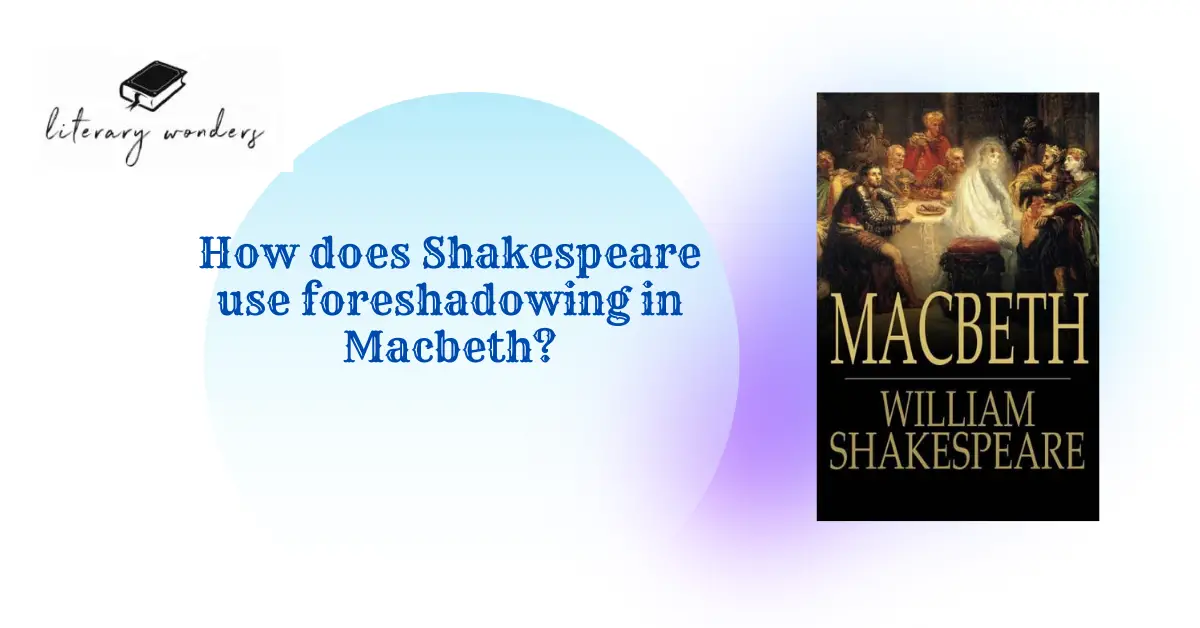Foreshadowing in Macbeth
Macbeth by William Shakespeare is a tragedy that displays several literary techniques, including foreshadowing, which serves to heighten the dramatic tension and anticipation throughout the play. Through the use of foreshadowing, Shakespeare provides subtle hints and clues about future events. These hints allow the audience to anticipate the tragic outcome that awaits the characters. Below are some examples to show how Shakespeare employs foreshadowing in “Macbeth” to create a sense of foreboding and inevitability.
Examples Of Foreshadowing in Macbeth
Example#1
The play, Macbeth opens with an iconic scene, where three witches also known as the Weird Sisters appear strangely. Their cryptic prophecies set the tone for the rest of the play and foreshadow Macbeth’s rise and fall. Their proclamation plants the seeds of ambition and intrigue in Macbeth’s mind such as;
“All hail, Macbeth! Hail to thee, Thane of Glamis!
All hail, Macbeth! Hail to thee, Thane of Cawdor!
All hail, Macbeth, that shalt be king hereafter!” (Act 1, Scene 3),
The fulfillment of these prophecies drives Macbeth’s ruthless pursuit of power and ultimately leads to his downfall. Furthermore, the imagery surrounding the witches, such as the “fog and filthy air” and their association with darkness and the supernatural, foreshadows the sinister events that will unfold later in the play. The witches’ eerie presence serves as a constant reminder of the moral corruption and chaos that will plague Scotland as a result of Macbeth’s actions.
Example#2
Another instance of foreshadowing occurs during Macbeth’s encounter with the witches in Act 4, Scene 1, where they conjure apparitions to deliver ambiguous warnings and predictions. The first apparition warns Macbeth to “Beware Macduff; / Beware the Thane of Fife” (Act 4, Scene 1), foreshadowing Macbeth’s eventual downfall at the hands of Macduff. This warning underscores the theme of betrayal and reinforces the idea that Macbeth’s tyrannical rule will ultimately lead to his demise.
Example#3
Additionally, the second apparition, a bloody child, tells Macbeth, “For none of woman born / Shall harm Macbeth” (Act 4, Scene 1). While this initially fills Macbeth with a false sense of security, it ultimately foreshadows his fate at the hands of Macduff, who reveals that he was “from his mother’s womb / Untimely ripped” (Act 5, Scene 8), fulfilling the prophecy and sealing Macbeth’s fate.
Other Techniques in Macbeth
Shakespeare utilizes imagery and symbolism to foreshadow the themes of guilt and conscience that permeate the play. For instance, Lady Macbeth’s obsessive attempts to wash the metaphorical bloodstains from her hands symbolize her guilt and foreshadow her descent into madness. Her famous soliloquy in Act 5, Scene 1, where she sleepwalks and compulsively tries to cleanse her hands, is a poignant reminder of the moral consequences of ambition and treachery.
Furthermore, the recurring motif of blood throughout the play serves as a powerful symbol of guilt, violence, and the inevitable consequences of Macbeth’s actions. From the moment Macbeth murders King Duncan to secure the throne, blood becomes a pervasive symbol that foreshadows the escalating cycle of violence and betrayal that consumes him and his wife.
Conclusion
To sum up, Shakespeare skilfully employs foreshadowing in Macbeth to heighten suspense, convey thematic depth, and foreshadow the tragic events that unfold. Through the prophetic warnings of the witches, the imagery of blood and darkness, and the symbolic significance of key motifs. Using powerful literary elements, he creates a sense of inevitability and doom that underscores the moral and psychological complexity of his characters.
Suggested Readings

